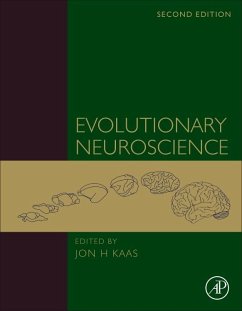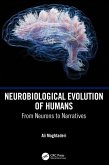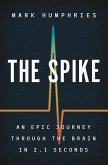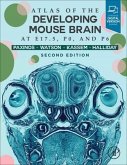Evolutionary Neuroscience
Herausgeber: H Kaas, Jon
Evolutionary Neuroscience
Herausgeber: H Kaas, Jon
- Gebundenes Buch
- Merkliste
- Auf die Merkliste
- Bewerten Bewerten
- Teilen
- Produkt teilen
- Produkterinnerung
- Produkterinnerung
Draws together research from eminent scientists from across the globe in the areas of phytoremediation and microbial remediation Includes case studies of engineered bacterial remediation Covers the genome editing CRISPR-Cas9 system that has been less explored in plants and microorganisms
Andere Kunden interessierten sich auch für
![Neurobiological Evolution of Humans Neurobiological Evolution of Humans]() Ali MoghtaderiNeurobiological Evolution of Humans207,99 €
Ali MoghtaderiNeurobiological Evolution of Humans207,99 €![The Spike The Spike]() Mark HumphriesThe Spike19,99 €
Mark HumphriesThe Spike19,99 €![The Ontogeny of Information The Ontogeny of Information]() Susan OyamaThe Ontogeny of Information113,99 €
Susan OyamaThe Ontogeny of Information113,99 €![Atlas of the Developing Mouse Brain Atlas of the Developing Mouse Brain]() George PaxinosAtlas of the Developing Mouse Brain157,99 €
George PaxinosAtlas of the Developing Mouse Brain157,99 €![Evolution Challenges Evolution Challenges]() Evolution Challenges177,99 €
Evolution Challenges177,99 €![Foundations in Evolutionary Cognitive Neuroscience Foundations in Evolutionary Cognitive Neuroscience]() Foundations in Evolutionary Cognitive Neuroscience167,99 €
Foundations in Evolutionary Cognitive Neuroscience167,99 €![A Brief History of Intelligence A Brief History of Intelligence]() Max Solomon BennettA Brief History of Intelligence28,44 €
Max Solomon BennettA Brief History of Intelligence28,44 €-
-
-
Draws together research from eminent scientists from across the globe in the areas of phytoremediation and microbial remediation Includes case studies of engineered bacterial remediation Covers the genome editing CRISPR-Cas9 system that has been less explored in plants and microorganisms
Hinweis: Dieser Artikel kann nur an eine deutsche Lieferadresse ausgeliefert werden.
Hinweis: Dieser Artikel kann nur an eine deutsche Lieferadresse ausgeliefert werden.
Produktdetails
- Produktdetails
- Verlag: Elsevier Science
- 2nd edition
- Seitenzahl: 962
- Erscheinungstermin: 28. Mai 2020
- Englisch
- Abmessung: 276mm x 216mm x 91mm
- Gewicht: 2810g
- ISBN-13: 9780128205846
- ISBN-10: 0128205849
- Artikelnr.: 57909750
- Herstellerkennzeichnung
- Libri GmbH
- Europaallee 1
- 36244 Bad Hersfeld
- gpsr@libri.de
- Verlag: Elsevier Science
- 2nd edition
- Seitenzahl: 962
- Erscheinungstermin: 28. Mai 2020
- Englisch
- Abmessung: 276mm x 216mm x 91mm
- Gewicht: 2810g
- ISBN-13: 9780128205846
- ISBN-10: 0128205849
- Artikelnr.: 57909750
- Herstellerkennzeichnung
- Libri GmbH
- Europaallee 1
- 36244 Bad Hersfeld
- gpsr@libri.de
Part 1: History, Concepts, and Theory
1. History of Ideas on Brain Evolution
2. Phylogenetic Character Reconstruction
3. The role of endocasts in the study of brain evolution
4. Invertebrate origins of vertebrate nervous systems
Part 2: The Brains of Fish, Amphibians, Reptiles and Birds
5. The nervous systems of jawless vertebrates
6. The brains of cartilaginous fishes
7. The organization of the central nervous system of amphibians
8. The brains of reptiles and birds
9. Function and evolution of the reptilian cerebral cortex
10. The cerebellum of non-mammalian vertebrates
Part 3: Early Mammals and Subsequent Adaptations
11. Emergence of mammals
12. Mammalian Evolution: The phylogenetic story
13. Organization of neocortex in early mammals
14. What modern mammals teach us about the cellular composition of early
brains and mechanisms of brain evolution
15. Consistencies and variances in the anatomical organization of aspects
of the mammalian brain stem
16. Comparative anatomy of glial cells in mammals
17. The monotreme nervous system
18. Evolution of flight and echolocation in bats
19. Carnivore brains: Effects of sociality on inter- and intra-specific
comparisons of regional brain volumes
Part 4: Primates
20. Phylogeny of primates
21. Expansion of the cortical sheet in primates
22. Scaling up the simian primate cortex: A conserved pattern of expansion
across brain sizes
23. Evolution of visual cortex in primates
24. Evolution of subcortical pathways to the extrastriate cortex
25. Evolved mechanisms of high-level visual perception in primates
26. Evolution of parietal cortex in primates
27. Evolution of parietal-frontal networks in primates
28. Evolution of the prefrontal cortex in early primates and anthropoids
Part 5: Evolution of Human Brains
29. Introduction to human brain evolutionary studies
30. Human evolutionary history
31. Evolution of human life history
32. The fossil evidence of human brain evolution
33. Remarkable, but not special: What human brains are made of
34. Timing of brain maturation, early experience, and the human social
niche
35. Human association cortex: Expanded, untethered, neoteneous, and plastic
36. On the evolution of the frontal eye field: comparisons of monkeys, apes
and humans
37. The evolution of auditory cortex in humans
38. Language evolution
39. The search for human cognitive specializations
1. History of Ideas on Brain Evolution
2. Phylogenetic Character Reconstruction
3. The role of endocasts in the study of brain evolution
4. Invertebrate origins of vertebrate nervous systems
Part 2: The Brains of Fish, Amphibians, Reptiles and Birds
5. The nervous systems of jawless vertebrates
6. The brains of cartilaginous fishes
7. The organization of the central nervous system of amphibians
8. The brains of reptiles and birds
9. Function and evolution of the reptilian cerebral cortex
10. The cerebellum of non-mammalian vertebrates
Part 3: Early Mammals and Subsequent Adaptations
11. Emergence of mammals
12. Mammalian Evolution: The phylogenetic story
13. Organization of neocortex in early mammals
14. What modern mammals teach us about the cellular composition of early
brains and mechanisms of brain evolution
15. Consistencies and variances in the anatomical organization of aspects
of the mammalian brain stem
16. Comparative anatomy of glial cells in mammals
17. The monotreme nervous system
18. Evolution of flight and echolocation in bats
19. Carnivore brains: Effects of sociality on inter- and intra-specific
comparisons of regional brain volumes
Part 4: Primates
20. Phylogeny of primates
21. Expansion of the cortical sheet in primates
22. Scaling up the simian primate cortex: A conserved pattern of expansion
across brain sizes
23. Evolution of visual cortex in primates
24. Evolution of subcortical pathways to the extrastriate cortex
25. Evolved mechanisms of high-level visual perception in primates
26. Evolution of parietal cortex in primates
27. Evolution of parietal-frontal networks in primates
28. Evolution of the prefrontal cortex in early primates and anthropoids
Part 5: Evolution of Human Brains
29. Introduction to human brain evolutionary studies
30. Human evolutionary history
31. Evolution of human life history
32. The fossil evidence of human brain evolution
33. Remarkable, but not special: What human brains are made of
34. Timing of brain maturation, early experience, and the human social
niche
35. Human association cortex: Expanded, untethered, neoteneous, and plastic
36. On the evolution of the frontal eye field: comparisons of monkeys, apes
and humans
37. The evolution of auditory cortex in humans
38. Language evolution
39. The search for human cognitive specializations
Part 1: History, Concepts, and Theory
1. History of Ideas on Brain Evolution
2. Phylogenetic Character Reconstruction
3. The role of endocasts in the study of brain evolution
4. Invertebrate origins of vertebrate nervous systems
Part 2: The Brains of Fish, Amphibians, Reptiles and Birds
5. The nervous systems of jawless vertebrates
6. The brains of cartilaginous fishes
7. The organization of the central nervous system of amphibians
8. The brains of reptiles and birds
9. Function and evolution of the reptilian cerebral cortex
10. The cerebellum of non-mammalian vertebrates
Part 3: Early Mammals and Subsequent Adaptations
11. Emergence of mammals
12. Mammalian Evolution: The phylogenetic story
13. Organization of neocortex in early mammals
14. What modern mammals teach us about the cellular composition of early
brains and mechanisms of brain evolution
15. Consistencies and variances in the anatomical organization of aspects
of the mammalian brain stem
16. Comparative anatomy of glial cells in mammals
17. The monotreme nervous system
18. Evolution of flight and echolocation in bats
19. Carnivore brains: Effects of sociality on inter- and intra-specific
comparisons of regional brain volumes
Part 4: Primates
20. Phylogeny of primates
21. Expansion of the cortical sheet in primates
22. Scaling up the simian primate cortex: A conserved pattern of expansion
across brain sizes
23. Evolution of visual cortex in primates
24. Evolution of subcortical pathways to the extrastriate cortex
25. Evolved mechanisms of high-level visual perception in primates
26. Evolution of parietal cortex in primates
27. Evolution of parietal-frontal networks in primates
28. Evolution of the prefrontal cortex in early primates and anthropoids
Part 5: Evolution of Human Brains
29. Introduction to human brain evolutionary studies
30. Human evolutionary history
31. Evolution of human life history
32. The fossil evidence of human brain evolution
33. Remarkable, but not special: What human brains are made of
34. Timing of brain maturation, early experience, and the human social
niche
35. Human association cortex: Expanded, untethered, neoteneous, and plastic
36. On the evolution of the frontal eye field: comparisons of monkeys, apes
and humans
37. The evolution of auditory cortex in humans
38. Language evolution
39. The search for human cognitive specializations
1. History of Ideas on Brain Evolution
2. Phylogenetic Character Reconstruction
3. The role of endocasts in the study of brain evolution
4. Invertebrate origins of vertebrate nervous systems
Part 2: The Brains of Fish, Amphibians, Reptiles and Birds
5. The nervous systems of jawless vertebrates
6. The brains of cartilaginous fishes
7. The organization of the central nervous system of amphibians
8. The brains of reptiles and birds
9. Function and evolution of the reptilian cerebral cortex
10. The cerebellum of non-mammalian vertebrates
Part 3: Early Mammals and Subsequent Adaptations
11. Emergence of mammals
12. Mammalian Evolution: The phylogenetic story
13. Organization of neocortex in early mammals
14. What modern mammals teach us about the cellular composition of early
brains and mechanisms of brain evolution
15. Consistencies and variances in the anatomical organization of aspects
of the mammalian brain stem
16. Comparative anatomy of glial cells in mammals
17. The monotreme nervous system
18. Evolution of flight and echolocation in bats
19. Carnivore brains: Effects of sociality on inter- and intra-specific
comparisons of regional brain volumes
Part 4: Primates
20. Phylogeny of primates
21. Expansion of the cortical sheet in primates
22. Scaling up the simian primate cortex: A conserved pattern of expansion
across brain sizes
23. Evolution of visual cortex in primates
24. Evolution of subcortical pathways to the extrastriate cortex
25. Evolved mechanisms of high-level visual perception in primates
26. Evolution of parietal cortex in primates
27. Evolution of parietal-frontal networks in primates
28. Evolution of the prefrontal cortex in early primates and anthropoids
Part 5: Evolution of Human Brains
29. Introduction to human brain evolutionary studies
30. Human evolutionary history
31. Evolution of human life history
32. The fossil evidence of human brain evolution
33. Remarkable, but not special: What human brains are made of
34. Timing of brain maturation, early experience, and the human social
niche
35. Human association cortex: Expanded, untethered, neoteneous, and plastic
36. On the evolution of the frontal eye field: comparisons of monkeys, apes
and humans
37. The evolution of auditory cortex in humans
38. Language evolution
39. The search for human cognitive specializations








